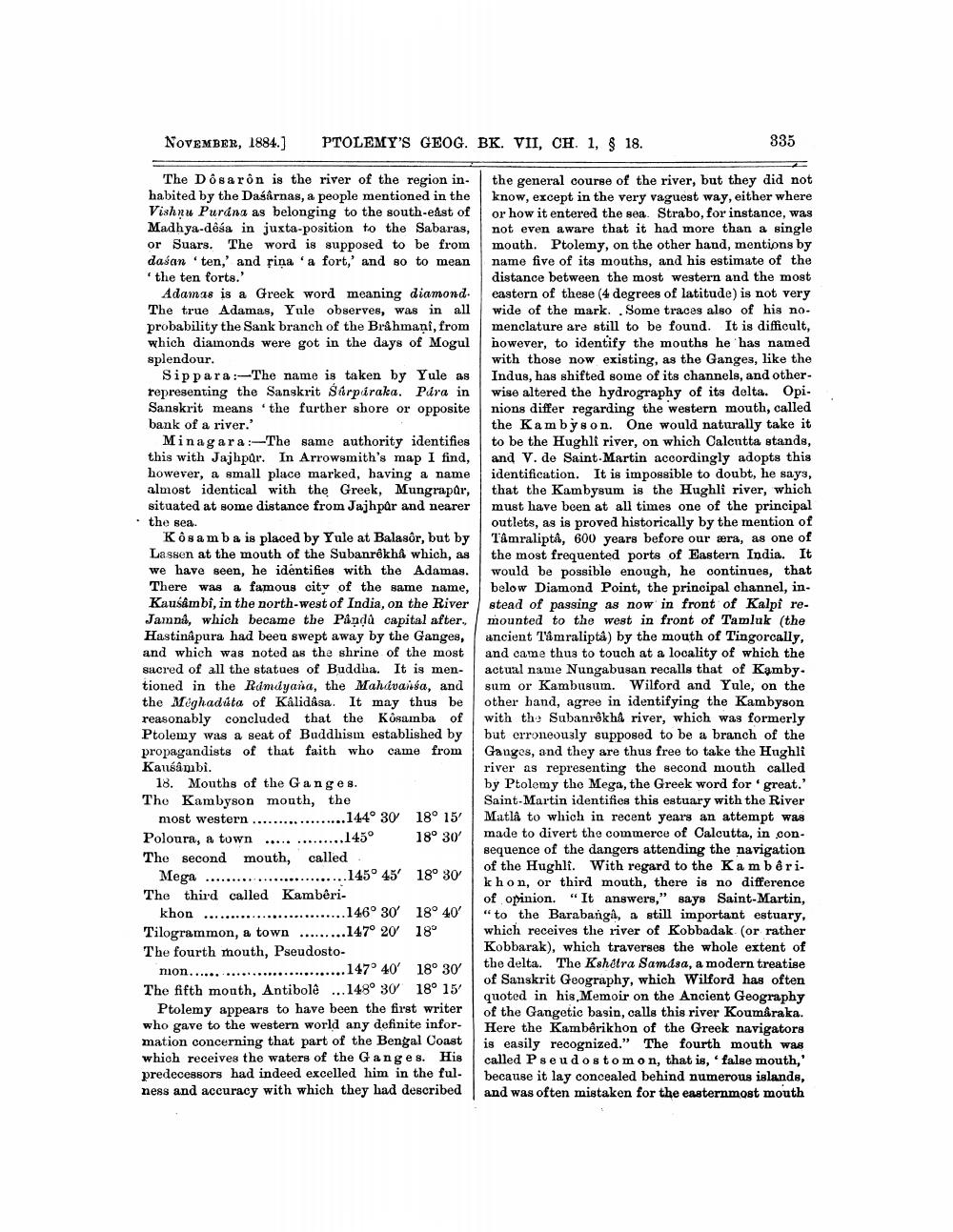________________
NOVEMBER, 1884.]
The Dôsaron is the river of the region inhabited by the Daśârnas, a people mentioned in the Vishnu Purána as belonging to the south-east of Madhya-dêsa in juxta-position to the Sabaras, or Suars. The word is supposed to be from dasan ten,' and rina a fort,' and so to mean 'the ten forts.'
PTOLEMY'S GEOG. BK. VII, CH. 1, § 18.
Adamas is a Greek word meaning diamond. The true Adamas, Yule observes, was in all probability the Sank branch of the Brahmani, from which diamonds were got in the days of Mogul splendour.
Sippara: The name is taken by Yule as representing the Sanskrit Sérpáraka. Pára in Sanskrit means the further shore or opposite bank of a river.'
Minagara: The same authority identifies this with Jajhpûr. In Arrowsmith's map I find, however, a small place marked, having a name almost identical with the Greek, Mungrapar, situated at some distance from Jajhpûr and nearer the sea.
Kôsamba is placed by Yule at Balasôr, but by Lassen at the mouth of the Subanrêkha which, as we have seen, he identifies with the Adamas. There was a famous city of the same name, Kausâmbi, in the north-west of India, on the River Jamna, which became the Pândů capital after., Hastinapura had been swept away by the Ganges, and which was noted as the shrine of the most sacred of all the statues of Buddha. It is mentioned in the Ramayana, the Mahávania, and the Meghadúta of Kâlidâsa. It may thus be reasonably concluded that the Kosamba of Ptolemy was a seat of Buddhism established by propagandists of that faith who came from Kausâmbi.
18. Mouths of the Ganges. The Kambyson mouth, the
most western. 144° 30′ 18° 15' .........145° Poloura, a town 18° 30' The second mouth, called Mega..... The third called Kambêrikhon
..145° 45′ 18° 30'
18° 40' 18°
.146° 30′ Tilogrammon, a town...147° 20′ The fourth mouth, Pseudostomon..... ..........147° 40' 18° 30' The fifth mouth, Antibolê ...148° 30′ 18° 15' Ptolemy appears to have been the first writer who gave to the western world any definite information concerning that part of the Bengal Coast which receives the waters of the Ganges. His predecessors had indeed excelled him in the fulness and accuracy with which they had described
335
the general course of the river, but they did not know, except in the very vaguest way, either where or how it entered the sea. Strabo, for instance, was not even aware that it had more than a single mouth. Ptolemy, on the other hand, mentions by name five of its mouths, and his estimate of the distance between the most western and the most eastern of these (4 degrees of latitude) is not very wide of the mark. . Some traces also of his nomenclature are still to be found. It is difficult, however, to identify the mouths he has named with those now existing, as the Ganges, like the Indus, has shifted some of its channels, and otherwise altered the hydrography of its delta. Opinions differ regarding the western mouth, called the Kambyson. One would naturally take it to be the Hughli river, on which Calcutta stands, and V. de Saint-Martin accordingly adopts this identification. It is impossible to doubt, he says, that the Kambysum is the Hughli river, which must have been at all times one of the principal outlets, as is proved historically by the mention of Tâmraliptâ, 600 years before our æra, as one of the most frequented ports of Eastern India. It would be possible enough, he continues, that below Diamond Point, the principal channel, instead of passing as now in front of Kalpi remounted to the west in front of Tamluk (the ancient Tâmraliptâ) by the mouth of Tingorcally, and came thus to touch at a locality of which the actual name Nungabusan recalls that of Kamby. sum or Kambusum. Wilford and Yule, on the other hand, agree in identifying the Kambyson with the Subanrêkha river, which was formerly but erroneously supposed to be a branch of the Ganges, and they are thus free to take the Hughli river as representing the second mouth called by Ptolemy the Mega, the Greek word for 'great.' Saint-Martin identifies this estuary with the River Matla to which in recent years an attempt was made to divert the commerce of Calcutta, in consequence of the dangers attending the navigation of the Hughli. With regard to the Kam bêrikhon, or third mouth, there is no difference of opinion. "It answers," says Saint-Martin, "to the Barabanga, a still important estuary, which receives the river of Kobbadak (or rather Kobbarak), which traverses the whole extent of the delta. The Kshetra Samása, a modern treatise of Sanskrit Geography, which Wilford has often quoted in his Memoir on the Ancient Geography of the Gangetic basin, calls this river Koumaraka. Here the Kambêrikhon of the Greek navigators is easily recognized." The fourth mouth was called Pseudos tomon, that is, 'false mouth,' because it lay concealed behind numerous islands, and was often mistaken for the easternmost mouth




